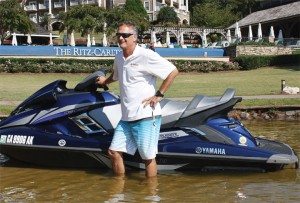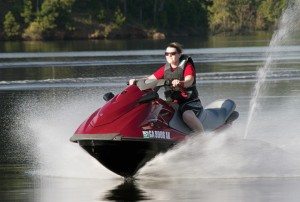Yamaha improves models across pricing spectrum
Low-end VX Series to flagship FX models receive upgrades
When Yamaha set out to improve its 2014 WaveRunner lineup, the OEM didn’t just focus on one series of models. Instead, it improved watercraft from its value-priced VX Series all the way up to its flagship FX Series.
Those improvements were recently on display in Georgia for a small group of media, including Powersports Business.
New engine and pump
The highlight of the launch was the introduction of the new SVHO 1,812cc, four-stroke, four-cylinder, supercharged and intercooled engine. Yamaha claims the new power plant is the segment’s most powerful, producing 20 percent more horsepower and torque than the previous SHO engine and 5 percent more hp than its nearest competitor.
Though Yamaha officials wouldn’t go on record with a number, talk among members of the enthusiast media at the The Ritz-Carlton Lodge, Reynolds Plantation in Greensboro, Ga., was that the engine tops 250 hp.
“It’s as powerful as I think we will need ever on a watercraft, unless the design changes and the requirements for power change,” Watercraft Group product manager Scott Watkins told Powersports Business during a ride on Lake Oconee.
The Super Vortex High Output engine is based off Yamaha’s 1.8-liter SHO, however, the new power plant delivers a range of improvements. A new high-performance intercooler increases cooling efficiency by 25 percent; a larger diameter supercharger impeller increases the air intake by 20 percent and increases supercharger boost by 60 percent; an all-new oil cooling system raises efficiency by 110 percent, and an advanced fuel injection system boosts fuel flow. Yamaha also boasts the addition of high-performance forged pistons.
“The pistons being forged allows them to withstand more heat. When you add more power, more fuel, naturally you’re adding more heat, more pressure, so you’ve got to make everything stronger to take that. And forging the pistons is a huge part of being able to get that extra power and maintain reliability,” Watkins said.
Though the SVHO is a big step up for Yamaha in terms of power, the OEM was mindful to use that power correctly, and therefore, a larger pump was added to give the engine the proper thrust. On SVHO models, Yamaha installed a 160mm pump, 5mm larger than the pump used on the SHO.

“The new pump is very key,” Watkins explained. “On a car, it is the backend and the tires, and if you’ve got the wrong rear end or gear ratio and the wrong tires and too much horsepower, you’re just going to sit there and spin the wheels, and that’s kind of what watercraft will do, too, if you don’t get the right amount of bite.”
The 160mm pump has eight stator veins, which better stabilize the water from twisting, and therefore prevent the watercraft from listing.
“There’s a lot of development that goes on in the diameter of the pump, the nozzle bore at the end, the opening at the beginning and the prop,” Watkins said.
Also aiding in the performance of the pump is a new top loader intake grate, which allows for more water flow to the unit.
“The intake grate is really the beginning of the pump. It’s where the water enters the hull, and the more water, of course, that you can get to that impeller, the more traction or the more thrust that you’re going to get out of it,” Watkins said.
The SVHO engine can be found in the 2014 Yamaha FZR (MSRP $14,999) and FZS ($14,999) and the flagship FX SVHO ($14,799) and FX Cruiser SVHO ($15,399).
VX Series improvements
Though unleashing a new, more powerful engine always lends itself to excitement, Yamaha made sure its low-end best-selling VX series was not ignored.
The hulls and decks on both the VX Cruiser and the VX Deluxe were upgraded to Yamaha’s NanoXcel material, which shaved considerable weight from the machines.
“We’re able to save about 65 pounds from the complete unit, which translates to quite a bit of benefit in the area of fuel economy, miles per gallon and of course, some performance benefits as well,” Watkins said.
In addition to increasing fuel efficiency, the NanoXcel hulls and decks contribute to quicker acceleration, faster top end speed and more range.
“It’s the little bit more fun factor because it’s a little lighter weight, so it’s a little more agile, more responsive,” Watkins said.
All models in the VX Series, which also includes the Sport, feature a 1,052cc four-stroke engine, open-loop cooling and expansive usable storage. The VX Cruiser and VX Deluxe include a remote transmitter security system and Low RPM Mode, which can reduce fuel consumption by up to 26 percent.
Along with the improvements to the VX Cruiser and Deluxe, Yamaha announced that the price of the VX Sport has been reduced to $7,999, a $400 decrease from 2013.

In the nine-years since the VX Series was introduced, it has been the best-selling PWC line on the market.
“Before 2005, the highest selling watercraft were the highest performing watercraft. Starting in 2005, that trend changed, and it’s been going the other direction ever since, where it’s the lower-end, lower-priced watercraft that are selling the most,” Watkins said. “Actually this trend kind of tells us, well you’re getting too high-priced. Those high performance ones are kind of pricing themselves up in an area where you’ve got less people that can buy them. We see it, so we’ve been focusing a lot on the VX series, trying to not overprice it; not over-feature it. Give it just what it needs, what people want to do — get out and have fun on the water.”
Continuing investment in PWC
The personal watercraft segment overall has not fared well for the industry since its heydays in the mid-1990s. In 1996, the industry sold 220,000 units, Watkins said. That number has dwindled to about 43,000 PWCs sold annually, and the 2013 season was relatively flat. Yet, Yamaha continues to invest in PWC as it still sees a market for what it’s producing.
“If you looked at that [20-year sales volume] chart, you’d be looking at it saying, ‘Well, we’re not going to put tens of millions of dollars into this industry, but we’re not going to turn away from it either,’” Watkins said.
As media zoomed past at least one decades-old docked WaveRunner during the Georgia event, it was evident why Yamaha continues to be the PWC market leader by a decent-sized margin.
“I’m a product guy, so I put a lot of weight on the product, of course, because it’s my shoulders,” Watkins said. “But then again our sales team and our sales network and service and just Yamaha in general and the reliability, it sells. Sometimes I think it’s got to be flashy and have all these features and all that, and really it’s just about getting on it, pulling the trigger and feeling what it does; that’s the feature right there.”
Click here to see Scott Watkins, Yamaha Watercraft Group’s product manager, give PSB an exclusive overview of the OEM’s new flagship FX Cruiser SVHO.








